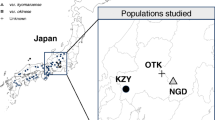Abstract
Based on the presence of intermediate morphological characters, such as serrated leaf margins and flower structures,Ilex x wandoensis was initially described as a putative natural hybrid betweenI. cornuta andI. Integra, and was formally described as a new hybrid species,I. x wandoensis C. F. Mill., and M. Kim. However, using molecular markers generated via random amplified polymorphic DNA (RAPD), we have now discovered hybridization in populations of theI. x wandoensis complex collected from Wando and Jeju Islands, Korea. Marker bands of the putative parent taxa also were found in some populations ofI. x wandoensis, confirming its hybrid origin. Morphological variability within and among those populations was confirmed by model-based clustering methods, using multilocus genotype data. Phenograms generated from RAPD bands indicated that some accessions ofI. x wandoensis clustered with one of the parental species. This implied the occurrence of hybridization and recurring backcrosses of the hybrid to both parents, resulting in various hybrid derivatives because of the segregation and recombination of traits.Ilex x wandoensis was more closely related toI. cornuta than toI. integra suggesting that it backcrossed more with the former than with the latter.
Similar content being viewed by others
Literature Cited
Anderson EC, Thompson EA (2002) A model-based method for identifying species hybrids using multilocus genetic data. Genetics160: 1217–1219
Dudley TR, Yinger BR (1987a) 1985 U.S. National Arboretum Plant Exploration in the Republic of Korea, Southwest Coast and Islands Final Report: Part II. Holly Soc J5: 10–16
Dudley TR, Yinger BR (1987b) 1985 U.S. National Arboretum Plant Exploration in the Republic of Korea, Southwest Coast and Islands Final Report: Part III. Holly Soc J5: 4–13
Dudley TR, Yinger BR (1988) 1985 US National Arboretum Plant Exploration in the Republic of Korea, Southwest Coast and Islands. Final Report: Part IV. Holly Soc J6: 5–13
Falush D, Stephens M, Pritchard JK (2003) Inference of population structure using multilocus genotype data: Linked loci and correlated allele frequencies. Genetics164: 1567–1587
Galle FC (1997) Hollies. The GenusIlex. Timber Press, USA
Gallez GP, Gottlieb LD (1982) Genetic evidence for the hybrid origin of the diploid plantStephanomeria diegensls. Evolution36: 1158–1167
Grant V (1981) Plant Speciation. Columbia University Press, New York
Howard DJ, Preszler RW, Williams J, Fenchel S, Boecklen WJ (1997) How discrete are oak species? Insights from a hybrid zone betweenQuercus grisea andQuercus gambelii. Evolution51: 747–755
Joung YH, Roh MS (2005) Mapping characterization ofPinus sylvestris var.sylvestriformis based on chloroplast DNA microsatellite markers. For Genet12: 89–98
Lee S, Ma S, Lim Y, Choi HK, Shin H (2004) Genetic diversity and its implications in the conservation of endangeredZostera japonica in Korea. J Plant Biol47: 275–281
Lee TB (1992) Illustrated Woody Plants of Korea. Forestry Research Institute, Forestry Administration
Lee YN (2002) Flora of Korea. Kyo-Hak, Seoul
Miller CF, Kim M (2002)Ilex x wandoensis C.F. Miller & M. Kim, a new hybrid species ofIlex (Aquifoliaceae) from Korea. Kor J Plant Tax32: 293–299
Morrell PL, Rieseberg LH (1998) Molecular tests of the proposed diploid hybrid origin ofGilia achilleifolia (Polemoniaceae). Amer J Bot85: 1439–1453
Pritchard JK, Stephens M, Donnelly P (2000) Inference of population structure using multilocus genotype data. Genetics155: 945–959
Raina SN, Rani V, Kojima T, Ogihara Y, Singh KR Dearumath RM (2001) RAPD and ISSR fingerprints as useful genetic markers for analysis of genetic diversity, varietal identification, and phylogenetic relationships in peanut (Arachis hypogaea) cultivars and wild species. Genome44: 763–772
Rieseberg LH (1995) The role of hybridization in evolution: Old wine in new skins. Amer J Bot82: 944–953
Rieseberg LH, Brouillet L (1994) Are many plant species paraphyletic? Taxon43: 21–32
Rieseberg LH, Brunsfeld SJ (1992) Molecular evidence and plant introgression,In PS Soltis, DE Soltis, JD Doyle, eds, Molecular Plant Systematics. Chapman and Hall, New York
Rieseberg LH, Ellstrand NC (1993) What can molecular and morphological markers tell us about hybridization? Crit Rev Plant Sci12: 213–241
Rieseberg LH, Raymond O, Rosenthal DM, Lai Z, Livingstone K, Nakazato T, Durphy JL, Schwarzbach AE, Donovan LA, Lexer C (2003) Major ecological transitions in wild sunflowers facilitated by hybridization. Science301: 1211–1216
Rieseberg LH, Wendel JF (1993) Introgression and its consequences in plants,In R Harrison, ed, Hybrid Zones and the Evolutionary Process. Oxford University Press
Roh MS, Lee AK, Suh JK, Slovin J (2006) Confirmation of cross-pollination ofArdisia crenata by sequence-characterized amplified region (SCAR) markers. Scient Hort109: 361–367
Rohlf FJ (2000) NTSYS-pc, Numerical Taxonomy and Multivariate Analysis System, version 2.1, Exeter Software, Setauket
Setoguchi H, Watanabe I (2000) Intersectional gene flow between insular endemics ofIlex (Aquifoliaceae) on the Bonin Islands and the Ryukyu Islands. Amer J Bot87: 793–810
Williams JGK, Kubelik AR, Livak KJ, Rafalski JA, Tingey SV (1990) DNA polymorphisms amplified by arbitrary primers are useful as genetic markers. Nucl Acids Res18: 6531–6535
Wolfe AD, Xiang QY, Kephart SR (1998) Assessing hybridization in natural populations ofPenstemon (Scrophulariaceae) using hypervariable intersimple sequence repeat (ISSR) bands. Mol Ecol7: 1107–1125
Author information
Authors and Affiliations
Corresponding author
Rights and permissions
About this article
Cite this article
Lee, N.S., Yeau, S.H., Park, J.O. et al. Molecular evidence for hybridization ofIlex x wandoensis (Aquifoliaceae) by RAPD analysis. J. Plant Biol. 49, 491–497 (2006). https://doi.org/10.1007/BF03031131
Received:
Accepted:
Issue Date:
DOI: https://doi.org/10.1007/BF03031131




